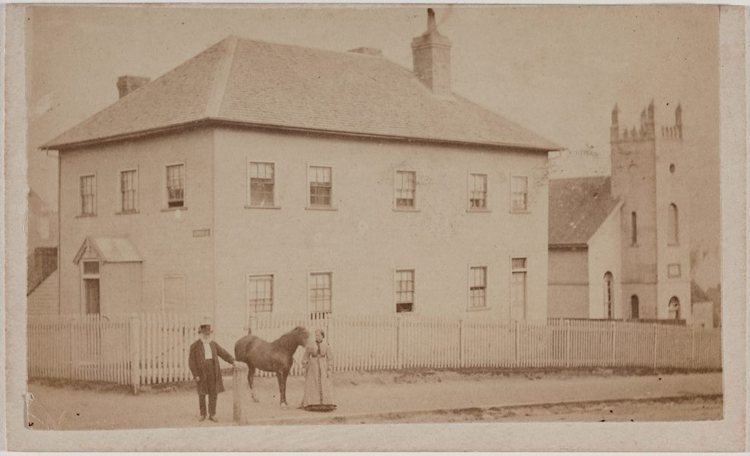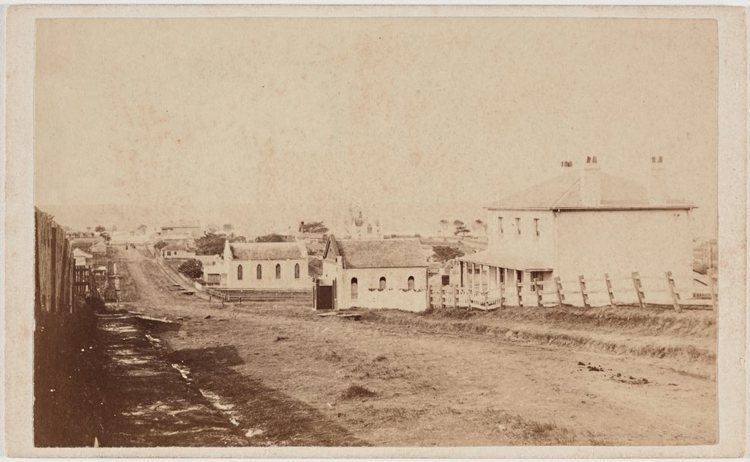Name Henry Merlin | ||
 | ||
Henry Beaufoy Merlin (c.1830—27 September 1873), photographer, was born in London, England, probably in 1830. He was the son of a chemist, Frederick Merlin, and his wife, Ann Harriet (nee Beaufoy).

Merlin and his mother arrived in Sydney from London as steerage passengers, on 8 December 1848.

By 1866 Merlin had established himself as a travelling photographer, using the business name of "American and Australian Photographic Company." He photographed the scenery but was chiefly involved in a house-by-house and shop-by-shop photographic coverage of the areas he visited. The photographs were sold to the owners of the premises mostly, it seems, for the purpose of sending them to distant relatives and friends as evidence of success achieved in a new country.
While in Melbourne plying his trade, Merlin visited the house of the Bayliss family and the young Charles Bayliss was fascinated by the photographic process employed by Merlin. Noting Charles' enthusiasm, Merlin employed him and the pair travelled to the Victorian gold diggings and then into parts of New South Wales.
The photographers used a covered caravan, pulled by a horse, as a darkroom. The collodion process was used on a glass photographic plate to capture an image on the plate. Merlin, Bayliss, and the caravan arrived in Hill End, New South Wales around the middle of 1872. While there, on 19 October 1872, a large matrix of gold and quartz was brought from the Star of Hope mine. One of the shareholders of the mine, Bernhardt Holtermann had Merlin photograph him with the gold.
Holtermann became wealthy as a result of the gold find and contracted Merlin to photograph places in New South Wales with a view to exhibiting the results abroad, to encourage immigration. Unfortunately, Merlin died before the work was completed. However it was carried on by Charles Bayliss.
Merlin died at his home at Leichhardt, New South Wales on 27 September 1873. As Keast Burke noted, he had "been betrayed by his great love; the wet-plate process called for fixation by means of the deadly potassium cyanide in the closely confined quarters of a coating caravan. Almost thirty years of continuous inhalation could not but threaten the lungs of the strongest man."
Whilst Merlin was well known as a photographer at the time of his death, it was not until 1951 that the extent of his photographic achievement, and that of his assistant, Charles Bayliss, was realised with the discovery of approximately 3,000 glass photographic negatives neatly packed in cedar boxes. The find was subsequently titled the Holtermann Collection in honour of Bernhardt Holtermann, who had financed the enterprise of taking the photographs.
Beyond photography, Merlin's talents extended to the field of Journalism. He wrote many articles for the Australian Town and Country Journal, accompanied by engravings based on his photographs.
Little is known of Merlin's personal life. It seems that in 1863, at the age of 33, he returned to England where he married Louisa Foster. The couple had four children. After Merlin's death his wife and children returned to England. Merlin's mother found herself in financial distress following his death, and funds were collected to assist her.
Merlin's lasting legacy is the Holtermann Collection. As Keast Burke put it "Australia must forever owe a deep debt of gratitude to Beaufoy Merlin, for his photography proved to be the true historian of that time and place—incomparable, authentic unchallengeable."
